
Varian Microeconomics Workout
.pdf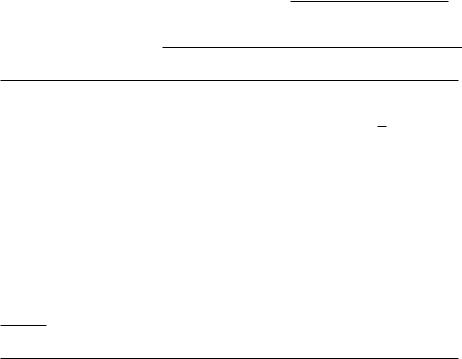
referring to your diagram.
.
19.2 (0) A Los Angeles ¯rm uses a single input to produce a recreational commodity according to a production function f(x) = 4px, where x is the number of units of input. The commodity sells for $100 per unit. The input costs $50 per unit.
(a) Write down a function that states the ¯rm's pro¯t as a function of
the amount of input. |
|
|
|
. |
(b) What is the pro¯t-maximizing amount of input? |
|
of output? |
||
How much pro¯ts does it make when it maximizes pro¯ts?
.
(c) Suppose that the ¯rm is taxed $20 per unit of its output and the price of its input is subsidized by $10. What is its new input level?
|
What is its new output level? |
|
How much pro¯t does |
||
it make now? |
|
(Hint: A good way to solve this is to write an |
|||
|
|||||
expression for the ¯rm's pro¯t as a function of its input and solve for the pro¯t-maximizing amount of input.)
(d) Suppose that instead of these taxes and subsidies, the ¯rm is taxed at 50% of its pro¯ts. Write down its after-tax pro¯ts as a function
of the amount of input. |
|
|
|
What is the pro¯t- |
||
maximizing amount of output? |
|
How much pro¯t does it make |
||||
after taxes? |
|
|
. |
|||
19.3 (0) Brother Jed takes heathens and reforms them into righteous individuals. There are two inputs needed in this process: heathens (who are widely available) and preaching. The production function has the following form: rp = minfh; pg, where rp is the number of righteous persons produced, h is the number of heathens who attend Jed's sermons, and p is the number of hours of preaching. For every person converted, Jed receives a payment of s from the grateful convert. Sad to say, heathens do not °ock to Jed's sermons of their own accord. Jed must o®er heathens a payment of w to attract them to his sermons. Suppose the amount of preaching is ¯xed at p¹ and that Jed is a pro¯t-maximizing prophet.
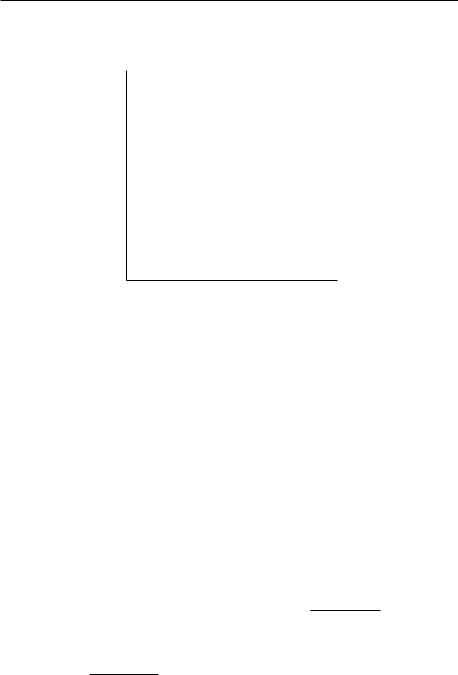
(a) If h < p¹, what is the marginal product of heathens? |
|
|
|
What |
||
|
|
|
||||
is the value of the marginal product of an additional heathen? |
|
|
|
. |
||
(b) If h > p¹, what is the marginal product of heathens? |
|
|
What |
|||
is the value of the marginal product of an additional heathen in this case?
.
(c) Sketch the shape of this production function in the graph below. Label the axes, and indicate the amount of the input where h = p¹.
(d) If w < s, how many heathens will be converted? |
|
If w > s, |
||
how many heathens will be converted? |
|
|
. |
|
19.4 (0) Allie's Apples, Inc. purchases apples in bulk and sells two products, boxes of apples and jugs of cider. Allie's has capacity limitations of three kinds: warehouse space, crating facilities, and pressing facilities. A box of apples requires 6 units of warehouse space, 2 units of crating facilities, and no pressing facilities. A jug of cider requires 3 units of warehouse space, 2 units of crating facilities, and 1 unit of pressing facilities. The total amounts available each day are: 1,200 units of warehouse space, 600 units of crating facilities, and 250 units of pressing facilities.
(a) If the only capacity limitations were on warehouse facilities, and if all warehouse space were used for the production of apples, how many
boxes of apples could be produced in one day? How many jugs of cider could be produced each day if, instead, all warehouse space were used in the production of cider and there were no other capacity
constraints? Draw a blue line in the following graph to represent the warehouse space constraint on production combinations.
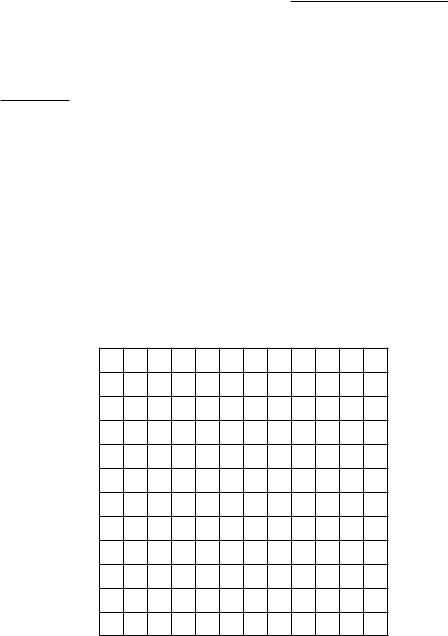
(b) Following the same reasoning, draw a red line to represent the constraints on output to limitations on crating capacity. How many boxes of apples could Allie produce if he only had to worry about crating capacity?
How many jugs of cider? |
|
. |
(c) Finally draw a black line to represent constraints on output combinations due to limitations on pressing facilities. How many boxes of apples could Allie produce if he only had to worry about the pressing capac-
ity and no other constraints? |
|
How many jugs of |
||
|
||||
cider? |
|
|
. |
|
(d) Now shade the area that represents feasible combinations of daily production of apples and cider for Allie's Apples.
Cider
600
500
400
300
200
100
0 |
100 |
200 |
300 |
400 |
500 |
600 |
|
|
|
|
|
|
Apples |
(e) Allie's can sell apples for $5 per box of apples and cider for $2 per jug. Draw a black line to show the combinations of sales of apples and cider that would generate a revenue of $1,000 per day. At the pro¯t-
maximizing production plan, Allie's is producing |
|
boxes of apples |
||||
and |
|
jugs of cider. Total revenues are |
|
|
. |
|
|
|
|
||||
19.5 (0) A pro¯t-maximizing ¯rm produces one output, y, and uses one input, x, to produce it. The price per unit of the factor is denoted by
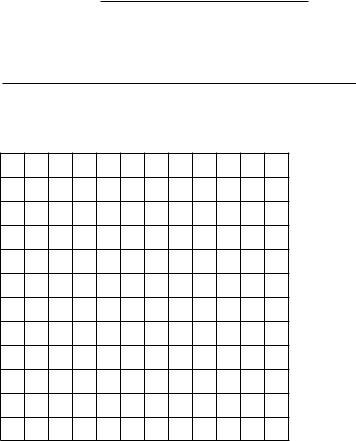
w and the price of the output is denoted by p. You observe the ¯rm's behavior over three periods and ¯nd the following:
Period |
y |
x |
w |
p |
1 |
1 |
1 |
1 |
1 |
2 |
2.5 |
3 |
.5 |
1 |
3 |
4 |
8 |
.25 |
1 |
(a) Write an equation that gives the ¯rm's pro¯ts, ¼, as a function of the amount of input x it uses, the amount of output y it produces, the
per-unit cost of the input w, and the price of output p. |
|
. |
(b) In the diagram below, draw an isopro¯t line for each of the three periods, showing combinations of input and output that would yield the same pro¯ts that period as the combination actually chosen. What are the
equations for these three lines? Using the theory of revealed pro¯tability, shade in the region on the graph that represents input-output combinations that could be feasible as far as one can tell from the evidence that is available. How would you describe this
region in words? .
Output
12
10
8
6
4
2
0 |
2 |
4 |
6 |
8 |
10 |
12 |
|
|
|
|
|
|
Input |
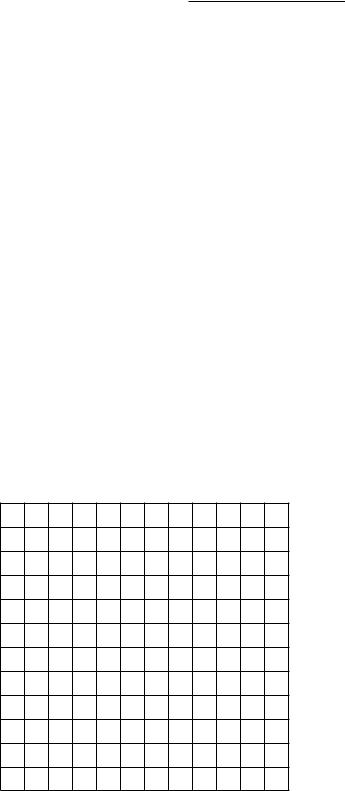
19.6 (0) T-bone Pickens is a corporate raider. This means that he looks for companies that are not maximizing pro¯ts, buys them, and then tries to operate them at higher pro¯ts. T-bone is examining the ¯nancial records of two re¯neries that he might buy, the Shill Oil Company and the Golf Oil Company. Each of these companies buys oil and produces gasoline. During the time period covered by these records, the price of gasoline °uctuated signi¯cantly, while the cost of oil remained constant at $10 a barrel. For simplicity, we assume that oil is the only input to gasoline production.
Shill Oil produced 1 million barrels of gasoline using 1 million barrels of oil when the price of gasoline was $10 a barrel. When the price of gasoline was $20 a barrel, Shill produced 3 million barrels of gasoline using 4 million barrels of oil. Finally, when the price of gasoline was $40 a barrel, Shill used 10 million barrels of oil to produce 5 million barrels of gasoline.
Golf Oil (which is managed by Martin E. Lunch III) did exactly the same when the price of gasoline was $10 and $20, but when the price of gasoline hit $40, Golf produced 3.5 million barrels of gasoline using 8 million barrels of oil.
(a) Using black ink, plot Shill Oil's isopro¯t lines and choices for the three di®erent periods. Label them 10, 20, and 40. Using red ink draw Golf Oil's isopro¯t line and production choice. Label it with a 40 in red ink.
Million barrels of gasoline
12
10
8
6
4
2
0 |
2 |
4 |
6 |
8 |
10 |
12 |
|
|
|
|
Million barrels of oil |
||

(b) How much pro¯ts could Golf Oil have made when the price of gasoline was $40 a barrel if it had chosen to produce the same amount that it did
when the price was $20 a barrel? |
|
|
What pro¯ts did |
|
Golf actually make when the price of gasoline was $40? |
|
. |
||
|
||||
(c) Is there any evidence that Shill Oil is not maximizing pro¯ts? Explain.
.
(d) Is there any evidence that Golf Oil is not maximizing pro¯ts? Explain.
.
19.7 (0) After carefully studying Shill Oil, T-bone Pickens decides that it has probably been maximizing its pro¯ts. But he still is very interested in buying Shill Oil. He wants to use the gasoline they produce to fuel his delivery °eet for his chicken farms, Capon Truckin'. In order to do this Shill Oil would have to be able to produce 5 million barrels of gasoline from 8 million barrels of oil. Mark this point on your graph. Assuming that Shill always maximizes pro¯ts, would it be technologically feasible for it to produce this input-output combination? Why or why not?
.
19.8 (0) Suppose that ¯rms operate in a competitive market, attempt to maximize pro¯ts, and only use one factor of production. Then we know that for any changes in the input and output price, the input choice and the output choice must obey the Weak Axiom of Pro¯t Maximization, ¢p¢y ¡ ¢w¢x ¸ 0.
Which of the following propositions can be proven by the Weak Axiom of Pro¯t Maximizing Behavior (WAPM)? Respond yes or no, and give a short argument.
(a) If the price of the input does not change, then a decrease in the price of the output will imply that the ¯rm will produce the same amount
or less output.
.
(b) If the price of the output remains constant, then a decrease in the input price will imply that the ¯rm will use the same amount or
more of the input.
.

(c) If both the price of the output and the input increase and the ¯rm
produces less output, then the ¯rm will use more of the input.
.
19.9 (1) Farmer Hoglund has discovered that on his farm, he can get 30 bushels of corn per acre if he applies no fertilizer. When he applies N pounds of fertilizer to an acre of land, the marginal product of fertilizer is 1 ¡ N=200 bushels of corn per pound of fertilizer.
(a) If the price of corn is $3 a bushel and the price of fertilizer is $p per pound (where p < 3), how many pounds of fertilizer should he use per
acre in order to maximize pro¯ts? |
|
. |
(b) (Only for those who remember a bit of easy integral calculus.) Write down a function that states Farmer Hoglund's yield per acre as a function
of the amount of fertilizer he uses. |
|
. |
(c) Hoglund's neighbor, Skoglund, has better land than Hoglund. In fact, for any amount of fertilizer that he applies, he gets exactly twice as much corn per acre as Hoglund would get with the same amount of fertilizer. How much fertilizer will Skoglund use per acre when the price of corn
is $3 a bushel and the price of fertilizer is $p a pound?
(Hint: Start by writing down Skoglund's marginal product of fertilizer as a function of N.)
(d) When Hoglund and Skoglund are both maximizing pro¯ts, will Skoglund's output be more than twice as much, less than twice as much
or exactly twice as much as Hoglund's? Explain.
.
(e) Explain how someone who looked at Hoglund's and Skoglund's corn yields and their fertilizer inputs but couldn't observe the quality of their land, would get a misleading idea of the productiv-
ity of fertilizer.
.
19.10 (0) A ¯rm has two variable factors and a production function,
f(x1; x2) = x11=2x12=4. The price of its output is 4. Factor 1 receives a wage of w1 and factor 2 receives a wage of w2.

(a) Write an equation that says that the value of the marginal product
of factor 1 is equal to the wage of factor 1 and an equation that says that the value of the marginal product of factor 2 is
equal to the wage of factor 2. Solve two equations in the two unknowns, x1 and x2, to give the amounts of factors 1 and 2 that maximize the ¯rm's pro¯ts as a function of w1 and w2. This gives
x1 = and x2 = (Hint: You could use the ¯rst equation to solve for x1 as a function of x2 and of the factor wages. Then substitute the answer into the second equation and solve for x2 as a function of the two wage rates. Finally use your solution for x2 to ¯nd the solution for x1.)
(b) If the wage of factor 1 is 2, and the wage of factor 2 is 1, how many
units of factor 1 will the ¯rm demand? |
|
|
How many units of |
||||
factor 2 will it demand? |
|
How much output will it produce? |
|||||
|
How much pro¯t will it make? |
|
|
. |
|||
19.11 (0) A ¯rm has two variable factors and a production function
f(x1; x2) = x11=2x12=2. The price of its output is 4, the price of factor 1 is w1, and the price of factor 2 is w2.
(a) Write the two equations that say that the value of the marginal prod-
uct of each factor is equal to its wage.
If w1 = 2w2, these two equations imply that x1=x2 = .
(b) For this production function, is it possible to solve the two marginal
productivity equations uniquely for x1 and x2? .
19.12 (1) A ¯rm has two variable factors and a production function f(x1; x2) = p2x1 + 4x2. On the graph below, draw production isoquants corresponding to an ouput of 3 and to an output of 4.
(a) If the price of the output good is 4, the price of factor 1 is 2, and the price of factor 2 is 3, ¯nd the pro¯t-maximizing amount of factor 1
|
, the pro¯t-maximizing amount of factor 2 |
|
, and the |
||
pro¯t-maximizing output |
|
|
. |
||
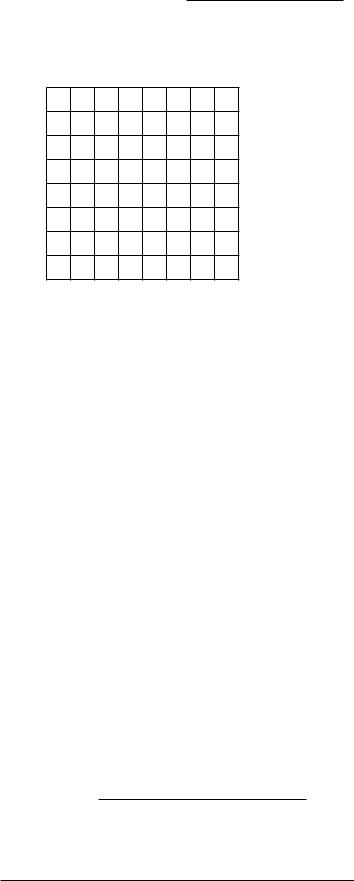
Factor 2
16
12
8
4
0 |
4 |
8 |
12 |
16 |
|
|
|
Factor 1 |
|
19.13 (0) A pro¯t-maximizing ¯rm produces one output, y, and uses one input, x, to produce it. The price per unit of the factor is denoted by w and the price of the output is denoted by p. You observe the ¯rm's behavior over three periods and ¯nd the following:
Period |
y |
x |
w |
p |
1 |
1 |
1 |
1 |
1 |
2 |
2.5 |
3 |
.5 |
1 |
3 |
4 |
8 |
.25 |
1 |
(a) Write an equation that gives the ¯rm's pro¯ts, ¼, as a function of the amount of input x it uses, the amount of output y it produces, the
per-unit cost of the input w, and the price of output p. |
|
. |
(b) In the diagram below, draw an isopro¯t line for each of the three periods, showing combinations of input and output that would yield the same pro¯ts that period as the combination actually chosen. What are the
equations for these three lines? Using the theory of revealed pro¯tability, shade in the region on the graph that represents input-output combinations that could be feasible as far as one can tell from the evidence that is available. How would you describe this
region in words? .
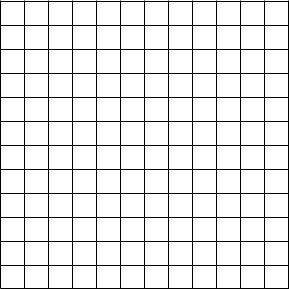
Output
12
10
8
6
4
2
0 |
2 |
4 |
6 |
8 |
10 |
12 |
|
|
|
|
|
|
Input |
19.14 (0) T-bone Pickens is a corporate raider. This means that he looks for companies that are not maximizing pro¯ts, buys them, and then tries to operate them at higher pro¯ts. T-bone is examining the ¯nancial records of two re¯neries that he might buy, the Shill Oil Company and the Golf Oil Company. Each of these companies buys oil and produces gasoline. During the time period covered by these records, the price of gasoline °uctuated signi¯cantly, while the cost of oil remained constant at $10 a barrel. For simplicity, we assume that oil is the only input to gasoline production.
Shill Oil produced 1 million barrels of gasoline using 1 million barrels of oil when the price of gasoline was $10 a barrel. When the price of gasoline was $20 a barrel, Shill produced 3 million barrels of gasoline using 4 million barrels of oil. Finally, when the price of gasoline was $40 a barrel, Shill used 10 million barrels of oil to produce 5 million barrels of gasoline.
Golf Oil (which is managed by Martin E. Lunch III) did exactly the same when the price of gasoline was $10 and $20, but when the price of gasoline hit $40, Golf produced 3.5 million barrels of gasoline using 8 million barrels of oil.
(a) Using black ink, plot Shill Oil's isopro¯t lines and choices for the three di®erent periods. Label them 10, 20, and 40. Using red ink draw Golf Oil's isopro¯t line and production choice. Label it with a 40 in red ink.
